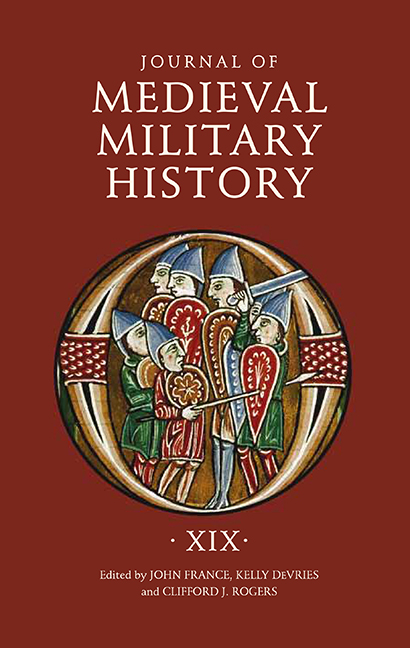Book contents
- Frontmatter
- Contents
- List of Illustrations
- 1 The Battle of Firāḍ: The Day on Which Khālid b. al-Walīd Did [Not] Defeat Both Byzantines and Persians
- 2 A Mislocated Battlefield? Battle Flats: The Battle of Stamford Bridge, 1066
- 3 The Frankish Campaign of 1133–1134 in Northern Syria and the Battle of Qinnasrīn
- 4 Bella Plus Quam Civilia? The Place of Battle in the Context of Civil War under the Anglo-Norman and Angevin Kings, c. 1100–c. 1217
- 5 Edward I’s War on the Continent, 1297–1298: A New Appraisal
- 6 The Earliest European Recipes for “Powder for Guns” (1336 and 1338–c. 1350)
- 7 Bellicose Rhetoric: The Memorable War Speeches of One Aragonese Royal Couple
- 8 Coureurs and Their Role in Late Medieval Warfare
- List of Contributors
- Journal of Medieval Military History 1477–545X
4 - Bella Plus Quam Civilia? The Place of Battle in the Context of Civil War under the Anglo-Norman and Angevin Kings, c. 1100–c. 1217
Published online by Cambridge University Press: 02 June 2021
- Frontmatter
- Contents
- List of Illustrations
- 1 The Battle of Firāḍ: The Day on Which Khālid b. al-Walīd Did [Not] Defeat Both Byzantines and Persians
- 2 A Mislocated Battlefield? Battle Flats: The Battle of Stamford Bridge, 1066
- 3 The Frankish Campaign of 1133–1134 in Northern Syria and the Battle of Qinnasrīn
- 4 Bella Plus Quam Civilia? The Place of Battle in the Context of Civil War under the Anglo-Norman and Angevin Kings, c. 1100–c. 1217
- 5 Edward I’s War on the Continent, 1297–1298: A New Appraisal
- 6 The Earliest European Recipes for “Powder for Guns” (1336 and 1338–c. 1350)
- 7 Bellicose Rhetoric: The Memorable War Speeches of One Aragonese Royal Couple
- 8 Coureurs and Their Role in Late Medieval Warfare
- List of Contributors
- Journal of Medieval Military History 1477–545X
Summary
This paper examines how the context of civil war in the Anglo-Norman and Angevin realms c. 1100–c. 1216 might further accentuate the challenges faced by leaders in making the critical decision as to whether to avoid or to commit to battle. Whereas a commander confronting an external opponent might withdraw or refusal battle until a more advantageous moment presented itself, a ruler whose legitimacy was contested could ill-afford to harm his authority by being seen to refuse trial by battle. If defeated, however, such authority could be gravely undermined and, as shown by the case of King Stephen's capture in 1141, the sacrality of kingship itself damaged. Conversely, while victory would bolster prestige and legitimacy, as well as striking a potentially decisive blow to rival forces, a leader's own desire to give battle might be compromised by fear of disloyalty and defection before or during battle, or thwarted by the nobility's deep-rooted reluctance to engage in a potentially self-destructive combat. While many nobles shrank from fighting against the person of the king during rebellion, battles fought in the context of civil wars reveal the significance of disinherited magnates in aggressive attacks upon their erstwhile lords.
“A greater event cannot take place among men than one wherein lies the fortunes of all the land, the state of the prince and the life of an infinite number of persons, the honour or dishonour of the overlord, the knights and all the nobility.” So wrote Christine de Pizan in her Livre des faites d’armes et de chevalerie, composed around 1410, concerning the enormous stakes that a pitched battle could involve. Much of her text comprises a vernacular reworking of Vegetius’ De re militari, and it has been the debate concerning the nature of “Vegetian strategy” and the place of battle within strategic thinking that has run, from the very first issue of the Journal of Medieval Military History, as a rich thematic seam through research on medieval warfare across a wide chronological and geographical span.
- Type
- Chapter
- Information
- Journal of Medieval Military HistoryVolume XIX, pp. 57 - 76Publisher: Boydell & BrewerPrint publication year: 2021



